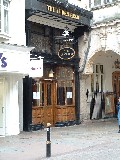White's Devon Directory (1850) states that a J.Sampson was resident at 202 High Street and further diectory listings
reveal how the pub may have possibly been extended from it's initial position on the High Street. Listings until 1878
give an address of 202 High Street, but in 1889 (K) a further address of 17 Waterbeer Street is given suggesting the
pub was extended through another building onto Waterbeer Street as seen today.
If you look at the roof-tops between High Street and Waterbeer Street today, it is fairly obvious that two buildings
are incorporated into the present day Turks Head, confirming Kelly's information in 1889.
1906 (B) and more recent listings show 202 and 203 High Street suggesting further lateral extension before 1906.
The EFP notes that John Chamberlain made extensive alterations in 1861, so this was probably the time some of these
changes were made. There was also a fire at the inn on 23rd December 1874 according to the EFP, so alterations will
also have taken place around this time.
Probably the first company to own the Turks Head was suggested as that headed by S. Davey, 1912 to 1919.
Directory Listings.
The pub was also mentioned by Slater (1852) in connection with the Carrier, Simon Coombe who started his trips to
Silverton from outside this pub. This was on a Tuesday and Friday.
The premises are noted in civic records of 1289 and the cellars date from 1310 and 1330 according to an advert in an
Exeter guidebook of 1960.
In 1669 and 1670, trade tokens were issued by the Turks Head Coffee House, the owner was Archier or Archior Brocas.
Coffee at this time was a very popular newly-introduced drink. The tokens had the name of the pub and proprietor on one
side and a coffee pot held by a hand issuing steam on the obverse.
In the C19th, the Mayor of Exeter used to have his Christmas dinner in the Turks, a roast beef extravaganza for
himself and around a dozen council knobs.
The Turks Head is a knot and can be tied around spars, ropes and even bottle necks which may be why it is often
used as a pub name. It is primarily a decorative knot but can be used as a stopper. However, this pub most likely got it's
name from a Turkish prisoner held here when part of the building was used as a prison. He had his head chopped off by
his executioner.
In the C16th and C17th North Africans were referred to as Turks. The Ottoman Empire with Constantinople (Istanbul)
as it's power base had reached it's zenith during the C16th under the reigns of Selim I and Sulayman I.
However the name may well be in reference to the crusades suggesting that the pub may well be earlier than C16th.
During the reign of Richard the Lionheart (1189 to 1199), the heyday of the Crusades, many pubs were named,
"The Saracen's Head" indicative of the number of gory souvenirs brought back by the
crusaders from the Holy Land.
It is therefore quite likely that this Turks Head evolved from the name The
Saracen's Head.
Stuart Callon Copyright ©2002-2005
